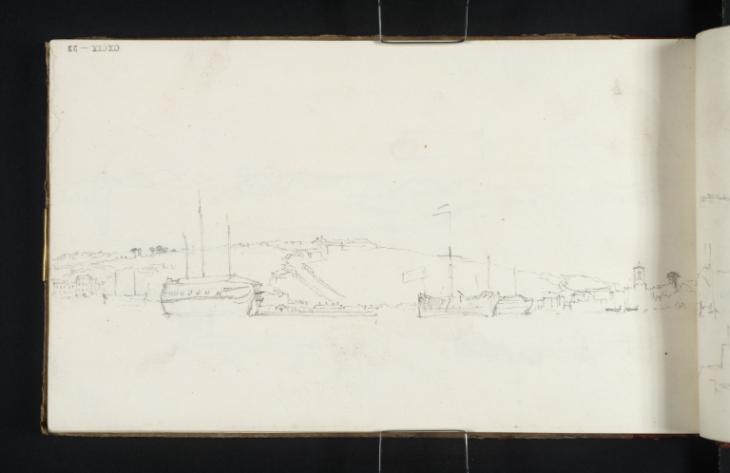Joseph Mallord William Turner At Chatham, on the River Medway c.1821
Joseph Mallord William Turner,
At Chatham, on the River Medway
c.1821
Joseph Mallord William Turner 1775–1851
Folio 22 Recto:
At Chatham, on the River Medway c.1821
D17402
Turner Bequest CXCIX 22
Turner Bequest CXCIX 22
Pencil on white wove paper, 112 x 190 mm
Stamped in black ‘CXCIX – 22’ top left, upside down
Stamped in black ‘CXCIX – 22’ top left, upside down
Accepted by the nation as part of the Turner Bequest 1856
References
1909
A.J. Finberg, A Complete Inventory of the Drawings of the Turner Bequest, London 1909, vol.I, p.608, CXCIX 22, as ‘At Chatham’.
Turner looks north east towards the Great Lines above Chatham, visible here slightly towards the left. They mark the otherwise largely blank expanse of hillside with a distinctive, angular wound. The view describes the opposite perspective to the one represented in the watercolour Chatham, from Fort Pitt of about 1830 (private collection)2 engraved in 1832 as part of the ambitious Picturesque Views in England and Wales project of the 1820s and 1830s (Tate impressions: T04588–T04589, T05089). The tower of the Royal Dockyard Church, visible at far left in the watercolour and engraving, seems apparent at far right in this sketch. A darkly shaded shape, presumably a tree, is evident to the right of the church. The same arrangement is recorded in the top drawing on the facing page, folio 21 verso (D17401), although the distance between the two forms is somewhat further. The foreground of the present sketch is dedicated to detailed drawings of a wide variety of vessels. These range from a stout hulk at left, to a pair of light craft indicated at far right, with the interlinking space populated by what are probably ships of the line.
By the middle of the eighteenth century, the Royal Dockyards at Chatham had become one of the largest industrial organisations globally, boasting advanced facilities and an enormous, skilled workforce.3 Shortly before Turner recorded his impressions of Chatham in the current sketchbook, great plans for further development had begun to be put into action. The southern end of the Dockyard was modernised, with the installation of a new Double Ropehouse, the great Anchor Wharf Storehouses, and Edward Holl’s Lead and Paint Mill in 1817.4 Close to the centre of the site, Holl also constructed the Royal Dockyard Church evident on this page.5 Elsewhere, a steam powered Saw Mill was erected, ‘one of Britain’s earliest mechanical saw mills and the first use of steam at Chatham’.6 The year 1820 saw the building of Chatham’s first stone dry dock, and engine house for a steam-powered dock pump.7
For additional examples of identified or presumed views of Chatham, see folios 14 verso, 15 recto, 19 verso, 21 verso, 22 verso, 23 recto, 24 recto, 46 verso, 47 verso, 48 recto, 51 recto and verso, 52 recto, 55 recto and verso, 56 verso, 57 verso, 58 verso, 59 recto, 75 recto, 76 verso, 77 recto, 78 recto, and 89 verso (D17388–D17389, D17397, D17401, D17403–D17404, D17406, D17444, D17446–D17447, D17450–D17452, D17455–D17457, D17459, D17461–D17462, D17479, D17482–D17483, D17485, D17505). Also see the Folkestone sketchbook in this section, of about 1821–2 (Tate D17221–D17222; Turner Bequest CXCVIII 8a–9); and the Gravesend and Margate sketchbook of around 1830 (Tate D27345–D27346, D27351, D27354; Turner Bequest CCLXXIX 42–42a, 45, and 46a). In addition, there are also two watercolour studies of Chatham (Tate D25231, D25286; Turner Bequest CCLXIII 109 and 164), and two prints of Rochester, Stroud and Chatham of about 1838 (Tate impressions: T05104, T06127), after a painting by Turner destroyed by fire in 1955.8
Maud Whatley
January 2016
‘Royal Dockyards’, accessed 31 December 2015, The Historic Dockyard Chatham, http://www.thedockyard.co.uk/history-and-buildings/dockyards-history/royal-dockyards/ .
‘Mechanisation and Industrialisation (1780-1832)’, The Historic Dockyard Chatham, accessed 31 December 2015, http://www.thedockyard.co.uk/history-and-buildings/dockyards-history/mechanisation-industrialisation/ .
How to cite
Maud Whatley, ‘At Chatham, on the River Medway c.1821 by Joseph Mallord William Turner’, catalogue entry, January 2016, in David Blayney Brown (ed.), J.M.W. Turner: Sketchbooks, Drawings and Watercolours, Tate Research Publication, February 2017, https://www

